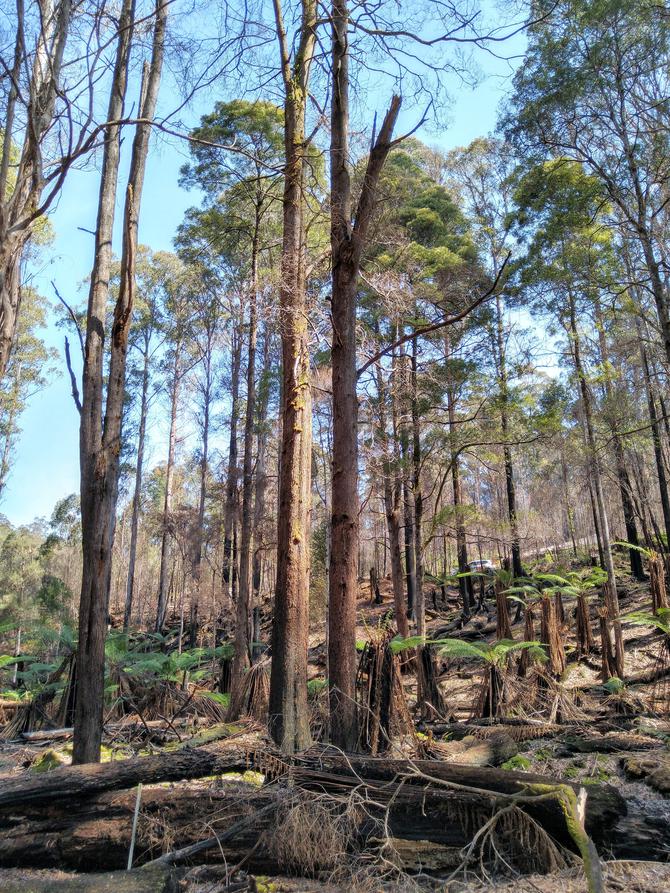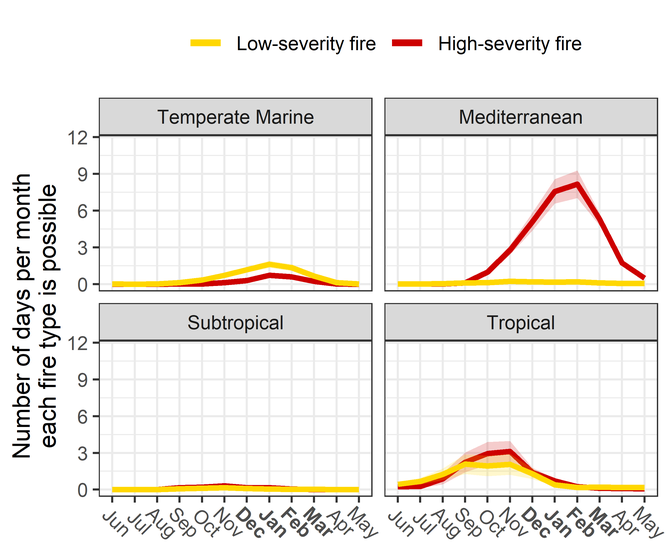They store more carbon than any other forest type, they provide drinking water for some of Australia’s largest population centres, and support Australia’s forest industries. Furthermore, their relationship with fire is quite complicated, as they share the same ecological and climatic niche as rainforests (rainforest trees often occupy TWEF understoreys), which burn only during extreme droughts.
However, being Eucalyptus-dominated, fire is an integral part of the life cycle of TWEF, as eucalypts require fire to regenerate. However, that TWEF occupies a rainforest niche makes bushfire rare, meaning that that data on bushfires in these forests is difficult to find.
Fire types
Importantly, fire, and more specifically, the type of fire, plays an key role in the population dynamics these forests.
In fire ecology, we often refer to fires as being ‘high-severity’ or ‘low-severity’. High-severity fires are intense fires with tall flames that damage the forest canopy and sometimes kill all the trees.
Low-severity fires, on the other hand, creep through the understorey, killing small trees, but leave the canopy intact.
High-severity fires, especially ones that kill all the trees, can simplify forest structure by initiating the establishment of a dense cohort of seedlings, and potentially increase landscape-scale flammability. Further, multiple high-severity fires in quick succession have been shown to cause ecological collapse in some TWEF. Meanwhile, low-severity fire can help maintain structural complexity and its associated wildlife habitat, avoid catastrophic carbon loss, while still creating conditions suitable for eucalypt regeneration.
Therefore, understanding the likelihood of low- and high-severity fire in this ecosystem, and how this might be affected by climate change, is important.

Predicting fires
In our new study published today, we endeavored to do just that: predict the likelihood of both low- and high-severity fire in TWEF. We looked at TWEF across the continent of Australia, from the cool, wet temperate climates in the southeast, to the hot, humid tropical climates of the north, to the hot, dry Mediterranean climates of the west.
We measured all the flammable materials in these forests. In the absence of actual data on bushfires in these forests, we used mathematical models and historical climate data to predict how frequently low- and high-severity fires were possible in TWEF.
What we found may not surprise many people: forests in the hot and dry Mediterranean climates were much more likely to experience high-severity fire than those in the cool, wet southeast. However, perhaps more surprisingly, we found that low severity fires were much more likely than high severity fires in the southeastern states of Tasmania and Victoria, despite low-severity fire being largely ignored in previous discussions of the wildfire in TWEF in these states.
Meanwhile, according to our modelling, high-severity wildfire was much more likely than low-severity fire in the hot, dry Mediterranean climate of Western Australia. The implications of this should be self-evident, as the cool, temperate climate of southeastern Australia warms under climate change, the likelihood of high-severity wildfire, the kind that can cause ecological damage, especially if it happens repeatedly, will increase.

Ladder fuels
However, there is hope. A secondary finding of our study was that the ladder fuels in these forests (i.e. the small trees and shrubs in the understorey), are critical in the development of high-severity fires.
We found that if these ladder fuels do not burn, the likelihood of a high-severity fire is much lower. This means that management of these forests, when it mimics a natural fire regime, can be used as a tool to reduce the likelihood of a high-severity fire, and might help prevent catastrophic carbon loss. If we can remove these ladder fuels, or make them less flammable, this can help lower fire risk.
Such management could take many forms: understorey removal or variable density thinning (forms of logging), prescribed burning to remove elevated fuels, or irrigation or protection of rainforest understoreys to ensure the forest is difficult to ignite. The effect of these different management is poorly understood, so further research is needed to gauge their suitability for TWEF.
Given the vulnerability of these forests to climate change revealed by our study, we argue that there is an imperative to start to actively manage tall wet Eucalyptus forests in the face of a rapidly heating and fire prone world. Yet managing these forests in the face of changing climate presents challenges that are as much social and political as they are ecological.
Therefore, to preserve the last remaining stands of these high conservation value forests we need to start an informed, evidence based national conversation about acceptable, ecologically sustainable, and practical management interventions, and where and when they should be implemented. Otherwise, time may be running out for Australia’s forest giants.
This article was originally published on the British Ecological Society blog, and republished with permission.
